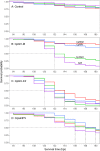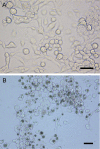Cryptophlebia peltastica Nucleopolyhedrovirus Is Highly Infectious to Codling Moth Larvae and Cells
- PMID: 31227557
- PMCID: PMC6696965
- DOI: 10.1128/AEM.00795-19
Cryptophlebia peltastica Nucleopolyhedrovirus Is Highly Infectious to Codling Moth Larvae and Cells
Abstract
Cydia pomonella granulovirus (CpGV) is a cornerstone of codling moth (Cydia pomonella) control in integrated and organic pome fruit production, though different types of resistance to CpGV products have been recorded in codling moth field populations in Europe for several years. Recently, a novel baculovirus named Cryptophlebia peltastica nucleopolyhedrovirus (CrpeNPV) was isolated from a laboratory culture of the litchi moth, Cryptophlebia peltastica, in South Africa. Along with CpGV, it is the third known baculovirus that is infectious to codling moth. In the present study, parameters of infectiveness of CrpeNPV, such as the median lethal concentration and median survival time, were determined for codling moth larvae susceptible or resistant to CpGV. In addition, the permissiveness of a codling moth cell line with respect to infection by CrpeNPV budded virus was demonstrated by infection and gene expression studies designed to investigate the complete replication cycle. Investigations of the high degree of virulence of CrpeNPV for codling moth larvae and cells are of high significant scientific and economic value and may offer new strategies for the biological control of susceptible and resistant populations of codling moth.IMPORTANCE The emergence of codling moth populations resistant to commercially applied isolates of CpGV is posing an imminent threat to organic pome fruit production. Very few CpGV isolates are left that are able to overcome the reported types of resistance, emphasizing the demand for new and highly virulent baculoviruses. Here we report the recently discovered CrpeNPV as highly infectious to all types of resistant codling moth populations with a high speed of killing, making it a promising candidate baculovirus in fighting the spread of resistant codling moth populations.
Keywords: CpGV resistance; alphabaculovirus; bioassays; biological control; cell culture; survival time analysis; virulence.
Copyright © 2019 American Society for Microbiology.
Figures



Similar articles
-
A Third Type of Resistance to Cydia pomonella Granulovirus in Codling Moths Shows a Mixed Z-Linked and Autosomal Inheritance Pattern.Appl Environ Microbiol. 2017 Aug 17;83(17):e01036-17. doi: 10.1128/AEM.01036-17. Print 2017 Sep 1. Appl Environ Microbiol. 2017. PMID: 28667116 Free PMC article.
-
Transcriptome analysis of CpGV in midguts of type II resistant codling moth larvae and identification of contaminant infections by SNP mapping of RNA-Seq data.J Virol. 2024 Jul 23;98(7):e0053724. doi: 10.1128/jvi.00537-24. Epub 2024 Jun 27. J Virol. 2024. PMID: 38934597 Free PMC article.
-
Novel Diversity and Virulence Patterns Found in New Isolates of Cydia pomonella Granulovirus from China.Appl Environ Microbiol. 2020 Jan 7;86(2):e02000-19. doi: 10.1128/AEM.02000-19. Print 2020 Jan 7. Appl Environ Microbiol. 2020. PMID: 31676472 Free PMC article.
-
Occurrence and Prevalence of Insect Pathogens in Populations of the Codling Moth, Cydia pomonella L.: A Long-Term Diagnostic Survey.Insects. 2013 Aug 2;4(3):425-46. doi: 10.3390/insects4030425. Insects. 2013. PMID: 26462428 Free PMC article. Review.
-
Insecticide resistance in the Cydia pomonella (L): Global status, mechanisms, and research directions.Pestic Biochem Physiol. 2021 Oct;178:104925. doi: 10.1016/j.pestbp.2021.104925. Epub 2021 Jul 15. Pestic Biochem Physiol. 2021. PMID: 34446201 Review.
Cited by
-
CpGV-M Replication in Type I Resistant Insects: Helper Virus and Order of Ingestion Are Important.Viruses. 2021 Aug 26;13(9):1695. doi: 10.3390/v13091695. Viruses. 2021. PMID: 34578277 Free PMC article.
-
The History of Baculovirology in Africa.Viruses. 2023 Jul 7;15(7):1519. doi: 10.3390/v15071519. Viruses. 2023. PMID: 37515205 Free PMC article. Review.
References
-
- Huber J. 1998. Western Europe, p 201–215. In Hunter-Fujita FR, Entwistle PF, Evans HF, Crook NE (ed), Insect viruses and pest management. Wiley, New York, NY.
-
- Lacey LA, Thomson D, Vincent C, Arthurs SP. 2008. Codling moth granulovirus: a comprehensive review. Biocontrol Sci Technol 18:639–663. doi:10.1080/09583150802267046. - DOI
-
- ICTV. 2016. Virus taxonomy: 2016 release. International Committee on Taxonomy of Viruses, London, United Kingdom: http://www.ictvonline.org/virustaxonomy.asp.
MeSH terms
LinkOut - more resources
Full Text Sources

